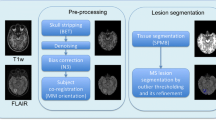Abstract
In this article, we describe the development and validation of an automatic algorithm to segment brain from extracranial tissues, and to classify intracranial tissues as cerebrospinal fluid (CSF), gray matter (GM), white matter (WM) or pathology. T1 weighted spin echo, dual echo fast spin echo (T2 weighted and proton density (PD) weighted images) and fast Fluid Attenuated Inversion Recovery (FLAIR) magentic resonance (MR) images were acquired ino 100 normal patients and 9 multiple sclerosis (MS) patients. One of the normal studies had synthesized MS-like lesions superimposed. This allowed precise measurement of the accuracy of the classification. The 9 MS patients were imaged twice in one week. The algorithm was applied to these data sets to measure reproducibility. The accuracy was measured based on the synthetic lesion images, where the true voxel class was known. Ninety-six percent of normal intradural tissue voxels (GM, WM, and CSF) were labeled correctly, and 94% of pathological tissues were labeled correctly. A low coefficient of variation (COV) was found (mean, 4.1%) for measurement of brain tissues and pathology when comparing MRI scans on the 9 patients. A totally automatic segmentation algorithm has been described which accurately and reproducibly segments and classifies intradural tissues based on both synthetic and actual images.
Similar content being viewed by others
References
Paty DW, Li DKB: Interferon beta-1b is effective in relapsing-remitting multiple sclerosis. II. MRI analysis of a multicenter, randomized, double-blind, placebo-controlled trial. Neurology 43:662–667, 1993
Simmons A, Arridge AR, Barker GJ, et al: Improvements to the quality of MRI cluster analysis. Magn Reson Imaging 12:1191–1204, 1994
Ostuni JL, Levin RL, Frank JA, et al: Correspondence of closest gradient voxels—a robust registration algorithm. J Magn Reson Imaging 7:410–415, 1997
Gerig G, Kubler O, Kikinis R, et al: Nonlinear anisotropic filtering of MRI data. IEEE Trans Med Imag 11:221–232, 1992
Vannier MS, Speidel CM, Rickman DL: Magnetic resonance imaging multispectral tissue classification. News Physiol Sci 3:148–154, 1988
Jackson EF, Narayana PA, Wolinsky JS, et al: Accuracy and reproducibility in volumetric analysis of multiple sclerosis lesions. J Comput Assist Tomogr 17:202–205, 1993
Clarke LP, Velthuizen RP, Phuphanich S, et al: MRI: Stability of three supervised segmentation techniques. Magn Reson Imaging 11:95–106, 1993
Velthuizen RP, Clarke LP, Phuphanich S, et al: Unsupervised measurement of brain tumor volume on MR images. J Magn Reson Imaging 5:594–605, 1995
Udupa JK, Wei L, Samarasekera S, et al: Detection and quantification of MS lesions using fuzzy topological principles. Proc SPIE 1996 2710:81–91, 1996
Ardekani BA, Braun M, Kanno I, et al: Automatic detection of intradural spaces in MR images. J Comput Assist Tomogr 18:963–969, 1994
Paty DW, Li DKB, Oger JF, et al: Magnetic resonance imaging in the evaluation of clinical trials in multiple sclerosis. Ann Neurol 36:S95-S96, 1994 (suppl)
Miller DH, Barkhof F, Berry I, et al: Magnetic resonance imaging in monitoring the treatment of multiple sclerosis: concerted action guidelines. J Neurol Neurosurg Psychiatry 54:683–688, 1991
Miller DH, Albert PS, Barkhof F, et al: Guidelines for the use of magnetic resonance techniques in monitoring the treatment of multiple sclerosis. US National MS Society Task Force. Ann Neurol 39:6–16, 1996
McDonald WI: NMR in diagnosis, monitoring treatment and epidemiology of multiple sclerosis. Acta Neurol Scand 161:52–53, 1995 (suppl)
McFarland HF, Frank JA, Albert PS, et al: Using gadolinium-enhanced magnetic resonance imaging lesions to monitor disease activity in multiple sclerosis. Ann Neurol 32:758–766, 1992
Paty DW: Magnetic resonance in multiple sclerosis. Curr Opin Neurol 6:202–208, 1993
Mitchell JR, Karlik SJ, Lee DH, et al: Computer-assisted identification and quantification of multiple sclerosis lesions in MR imaging volumes in the brain. J Magn Reson Imaging 4:197–208, 1994
Narayana PA, Jackson EF, Wolinsky JS, et al: Inter- and intraoperator variability in the quantitative volumetric measurements of multiple sclerosis lesions. J Magn Reson Imaging 3:111–124, 1993 (suppl)
Galagher HL, MacManus DG, Webb SL, et al: A reproducible repositioning method for serial magnetic resonance imaging studies of the brain in treatment trials for multiple sclerosis. J Magn Reson Imaging 7:439–441, 1997
Grossman RI: Magnetization transfer in multiple sclerosis. Ann Neurol 36:S97-S99, 1994
Barnes D, Munro PMG, Youl BD, et al: The longstanding MS lesion. A quantitative MRI and electron microscopic study. Brain 114:1271–1280, 1991
Author information
Authors and Affiliations
Rights and permissions
About this article
Cite this article
Erickson, B.J., Avula, R.T.V. An algorithm for automatic segmentation and classification of magnetic resonance brain images. J Digit Imaging 11, 74 (1998). https://doi.org/10.1007/BF03168729
DOI: https://doi.org/10.1007/BF03168729




